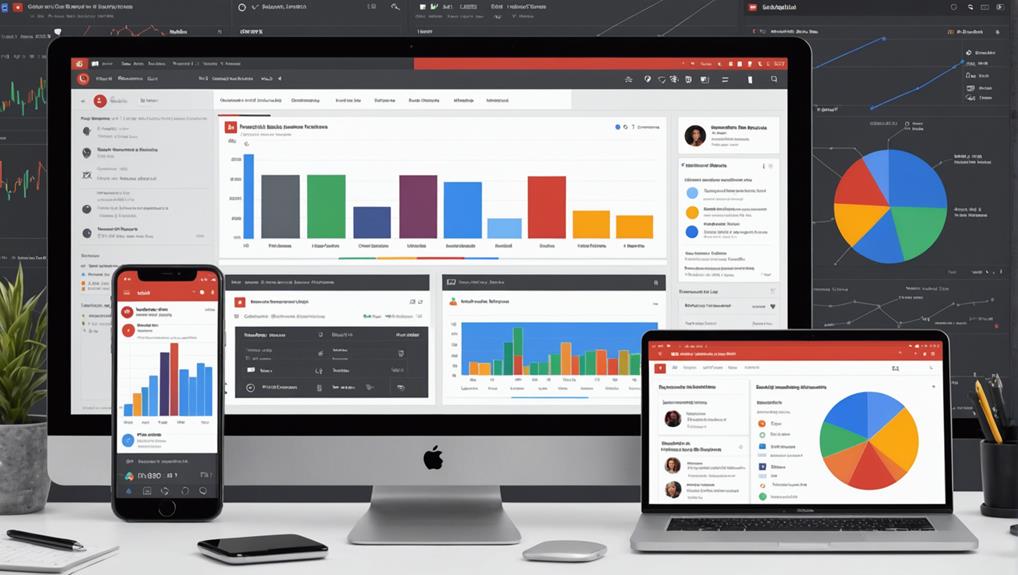To integrate YouTube Ads into your marketing strategy, start by setting measurable objectives aligned with your business goals. Conduct thorough audience research using Google Analytics, and build detailed buyer personas. Choose ad formats that capture attention and match audience preferences. Craft engaging, tailored content, and employ behavioral insights for precise targeting. Optimize bidding strategies by testing different options and adjusting based on performance. Regularly measure results with metrics like engagement rates, CTR, and ROAS, and refine your approach based on data-driven insights. Dive deeper into these strategies to maximize your campaign's effectiveness and drive better results.
Key Takeaways
- Align YouTube Ad objectives with overall business and marketing goals for cohesive strategy execution.
- Use audience insights from Google Analytics and YouTube Analytics to tailor ads to target demographics.
- Select ad formats and content that complement other marketing channels and campaigns.
- Regularly evaluate ad performance metrics to ensure they contribute to broader marketing objectives.
- Adjust bidding strategies based on performance data to optimize cost-efficiency and ROI.
Setting Clear Objectives
When integrating YouTube Ads into your marketing strategy, it's important to set clear, measurable objectives that align with your overall business goals. Start with specific goal setting to guarantee your YouTube Ad campaigns are focused and effective.
For instance, if your objective is to increase brand awareness, set quantifiable targets such as reaching a specific number of views or impressions. This type of goal setting will streamline your campaign optimization process.
Strategic planning is vital for aligning your YouTube Ad objectives with your broader marketing strategy. Whether you aim to generate leads, increase conversions, or boost brand engagement, having clearly defined goals will ensure coherence across all your marketing efforts.
By doing so, you'll create a unified approach that maximizes your campaign's impact.
Regular performance evaluation is key to understanding how well your YouTube Ads are meeting your objectives. Use metrics like click-through rates, conversion rates, and engagement levels to gauge success and identify areas for improvement.
This continuous assessment enables you to refine your strategy and drive better results. In summary, setting clear objectives not only guides your content creation and audience targeting but also enhances your overall integrated marketing success.
Researching Your Audience
To maximize your YouTube ad effectiveness, start by conducting thorough audience research to pinpoint key demographics and behaviors. Leverage tools like Google Analytics and YouTube Analytics to gather precise insights on age, gender, location, and online preferences.
Demographic Targeting Techniques
Conducting detailed demographic research is vital for identifying the key characteristics of your target audience, guaranteeing your YouTube ads engage the right viewers. Demographic segmentation involves dividing your audience into groups based on criteria like age, gender, income, and education level. By utilizing tools such as Google Analytics and social media insights, you can perform thorough audience profiling to gather in-depth data on your viewers' preferences, behaviors, and interests.
Tailoring your YouTube ad content to resonate with specific demographic segments enhances engagement and boosts conversions. For instance, a younger audience might respond better to dynamic, trendy visuals, while older viewers may appreciate informative, straightforward content. Implementing demographic targeting in your campaigns ensures your ads reach the right people, optimizing both engagement and ROI.
Regularly analyzing demographic data and refining your targeting strategies is essential. The digital landscape is constantly evolving, and so are the preferences and behaviors of your audience. By staying informed and adaptable, you can continuously improve your YouTube ad performance. This strategic approach not only maximizes your marketing efforts but also ensures your content remains relevant and impactful.
Behavioral Insights Utilization
Building on demographic targeting, leveraging behavioral insights allows you to understand your audience's preferences, behaviors, and decision-making processes on a deeper level. By conducting thorough behavioral analysis, you can segment your audience more accurately and tailor your YouTube ads to resonate with each distinct group. This approach goes beyond basic demographic data, diving into interests, online behaviors, and purchase patterns.
To start, gather data on how different audience segments interact with content. Look at metrics like watch time, click-through rates, and engagement levels. Use these insights to refine your ad messaging and creative elements, ensuring they align with the specific tastes and behaviors of your target segments.
For instance, if one segment shows a preference for tutorial videos, create ads that highlight how your product solves a particular problem. Behavioral insights also enable you to predict future actions, allowing for proactive ad optimization. By analyzing consumer behavior patterns, you can anticipate needs and tailor your campaigns accordingly.
This data-driven strategy not only enhances ad performance but also boosts engagement and overall campaign success. In essence, leveraging behavioral insights through audience segmentation and behavioral analysis maximizes the impact of your YouTube ads.
Choosing the Right Ad Format
Selecting the right ad format for your YouTube campaign is vital, as it directly influences cost-efficiency, viewer engagement, and overall marketing success. To start, consider factors like cost, reach, and user experience.
For instance, skippable in-stream ads might offer better cost efficiency and engagement since viewers can skip after five seconds, ensuring they only watch if interested. Ad placement is essential; targeting specific videos or channels can boost relevance and engagement.
Non-skippable ads, while potentially more costly, guarantee your message reaches the viewer in full, which can be beneficial for creative messaging that requires more time to convey value.
Optimize your video content for quality, relevance, and audience engagement. High-quality visuals and sound, along with a compelling narrative, can make your ad stand out. Test different versions of your video content to see which performs best. This iterative process helps refine your approach and boosts overall campaign effectiveness.
Choose ad formats that capture viewer attention, convey your value proposition, and motivate action effectively. Bumper ads, for instance, are six-second non-skippable ads that are perfect for delivering a quick, memorable message.
Ultimately, the right ad format will enhance engagement and contribute to your campaign's success on YouTube.
Crafting Engaging Content
Having selected the right ad format, the next step is to craft engaging content that captures viewer attention within the first few seconds and effectively conveys your value proposition. Data shows that viewers decide whether to skip an ad within the first 5 seconds, so you need to make an immediate impact.
Utilize visual storytelling to create a narrative that resonates with your audience. A compelling story not only grabs attention but also makes your message memorable.
Incorporating an emotional appeal can greatly boost engagement rates. Studies reveal that ads eliciting strong emotions are more likely to be shared and remembered. Whether it's humor, nostalgia, or excitement, tapping into emotions can create a deeper connection with your audience.
Tailor your content to your target audience's interests and preferences. Customized messages are 80% more likely to convert than generic ones.
Additionally, consider using interactive elements like polls, quizzes, or clickable links to encourage viewer participation. Interactive content can increase engagement by up to 47%.
Targeting Your Ads
Pinpointing your audience with YouTube's advanced targeting options can greatly enhance the relevance and effectiveness of your ads. By leveraging detailed buyer personas, you can hone in on precise segments of your audience, guaranteeing your ads resonate more deeply.
Here are four strategic steps to maximize your targeting:
- Demographic and Interest Targeting: Utilize YouTube's demographic filters to target specific age groups, genders, and household incomes. Combine this with interest targeting to reach users who are genuinely interested in your product or service.
- Keyword Selection and Audience Segmentation: Identify and select keywords that align closely with your brand and products. Segment your audience based on these keywords and other criteria like in-market audiences and remarketing lists to create highly relevant ad groups.
- Placement Optimization: Guarantee your ads appear on channels and videos that your target audience frequents. Use placement optimization to strategically choose where your ads are displayed for maximum impact.
- Geo Targeting Strategies: Focus on specific geographic locations where your potential customers are concentrated. Geo targeting strategies allow you to concentrate your ad spend on regions that show higher engagement and conversion rates.
Optimizing Bidding Strategies
To maximize the ROI of your YouTube Ads, fine-tune your bidding strategies by leveraging Maximum CPV and Target CPA options based on performance data. Start by testing these different bidding strategies to find the most effective approach for your campaign goals.
Utilize the Maximum CPV (Cost-Per-View) to control your bids for individual views, ensuring you don't overspend. Alternatively, the Target CPA (Cost-Per-Acquisition) can help you optimize for conversions, automating your bids to achieve your desired cost per acquisition.
Bid adjustment is essential for improving cost-efficiency. Regularly analyze your performance data and adjust bids based on the insights you gather. If a particular ad group or video is performing well, consider increasing your bid to capture more of that high-value traffic. Conversely, lower your bids on underperforming segments to reduce wasteful spending.
Performance monitoring is key to successful bid optimization. Use YouTube's automated bidding features to continuously refine your strategy. These tools dynamically adjust your bids in real-time, ensuring you're always optimizing for the best possible outcomes.
Effective bid management leads to lower costs, higher conversions, and a more successful ad campaign, driving your overall marketing strategy forward.
Measuring and Analyzing Results
To measure and analyze the results of your YouTube ads, focus on key performance indicators like views, engagement, and conversions. Use conversion tracking tools to gather detailed data and draw actionable insights.
Key Performance Indicators
Effective measurement of YouTube Ads hinges on tracking key performance indicators (KPIs) like views, engagement rates, click-through rates, conversions, and return on ad spend (ROAS). These metrics are essential for performance evaluation and campaign optimization, enabling you to gauge the effectiveness of your efforts and make data-driven decisions.
To strategically measure and analyze your YouTube Ad campaigns, focus on these key KPIs:
- Views: Monitor how many times your ad is watched. High view counts indicate broader reach and awareness.
- Engagement Rates: Track likes, shares, comments, and overall interaction. Higher engagement means your content resonates with the audience.
- Click-Through Rates (CTR): Measure the percentage of viewers who click on your ad. A higher CTR suggests that your ad was compelling and relevant.
- Conversions and ROAS: Assess the number of conversions and the return on ad spend. This helps you understand the direct impact on sales and revenue, allowing for better ROI assessment.
Conversion Tracking Tools
Utilizing conversion tracking tools is essential for accurately measuring and analyzing the impact of your YouTube ad campaigns on sales and revenue. By leveraging Google Analytics, you can track conversions from your ads and gain insights into how they contribute to your overall marketing goals.
Setting up conversion tracking in Google Ads allows you to monitor specific user actions, such as purchases or form submissions, after they interact with your YouTube ads.
Accurate conversion attribution is critical for understanding which ads drive meaningful actions. Measure key metrics like conversion rates, cost per conversion, and return on ad spend (ROAS) to evaluate the effectiveness of your campaigns.
Revenue tracking helps you see the direct financial impact of your YouTube ads, providing a clear picture of their value.
To get a comprehensive view of your campaign performance, analyze metrics such as lead generation, website visits, and other interactions attributed to your ads. This data-driven approach lets you optimize ad targeting, refine creative elements, and adjust bidding strategies.
Ultimately, using conversion tracking tools strategically boosts your ROI, making your YouTube ads a more powerful component of your overall marketing strategy.
Data-Driven Insights
Harnessing data-driven insights from YouTube Analytics empowers you to make strategic decisions that optimize your ad campaigns for maximum impact. By leveraging performance analytics, you can measure key metrics such as views, engagement, conversions, click-through rates, and return on ad spend. These insights allow you to refine your approach and make sure your ad spend optimization aligns with your business objectives.
Here's how you can utilize data-driven insights effectively:
- Track Key Metrics:
Focus on views, engagement, and conversions to understand how well your ads are performing. This helps you identify what's working and what needs improvement.
- Adjust Bidding Strategies:
Use performance analytics to tweak your bidding strategies, ensuring you're getting the most out of your budget. This can greatly enhance your ad spend optimization.
- Target Audience Segments:
Analyze data to identify which audience segments respond best to your ads. Tailoring your content to these segments can boost engagement and conversion rates.
- Conduct Competitive Analysis:
Compare your YouTube Ads performance with other channels. This in-depth view helps you gauge your overall marketing effectiveness and adjust strategies accordingly.
Frequently Asked Questions
How to Use Youtube Ads to Grow Your Business?
To grow your business, use YouTube ads with precise video targeting and audience segmentation. Leverage YouTube's vast reach and targeting options to boost brand awareness, drive traffic, and achieve a high click-through rate of 0.74%.
What Is the Marketing Strategy of Youtube?
YouTube's marketing strategy lets you use audience targeting and video SEO to reach specific demographics. You can optimize ad campaigns through Google Ads, leveraging data and analytics to enhance engagement and achieve your marketing objectives effectively.
Is Advertising on Youtube an Effective Method to Promote Products?
Advertising on YouTube is highly effective due to its precise audience targeting and versatile video formats. With 70% of viewers purchasing after seeing ads, your product promotion strategy will see significant engagement and conversion rates.
How to Integrate Paid Advertising in Your Content Marketing Strategy?
To integrate paid advertising in your content marketing strategy, focus on audience targeting and budget allocation. Identify your ideal audience, allocate budget wisely, and make sure your ads align with your content to maximize traffic, engagement, and conversions.
Conclusion
By integrating YouTube ads into your marketing strategy, you can effectively reach your target audience and achieve measurable results. Set clear objectives, understand your audience, choose the right ad format, and craft engaging content.
Strategically target and optimize your bidding strategies to maximize ROI. Regularly measure and analyze your results to refine your approach.
Harness YouTube's powerful platform to drive growth and boost your brand. Start today, and watch your marketing efforts thrive!




